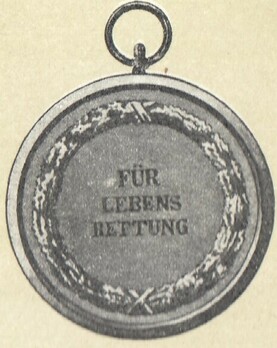Life Saving Medal, Type I, in Gold
CATEGORY: Version
SKU: 02.SXK.0115.101.01.000
Estimated market value:

Estimated market value:
A smooth circular medal with a raised edge, constructed of gold. The obverse features the right-facing heads of King Anton and Duke Friedrich August with the circular inscription ‘ANTON KOENIG UND FRIEDRICH AUGUST MITREGENT VON SACHSEN’ (‘King Anton and Co-Regent Friedrich August of Saxony’). The reverse features the inscription ‘FÜR LEBENS=RETTUNG’ (‘for life saving’), surrounded by an oak leaf wreath that is cross-tied by a ribbon at the top and bottom. On a loop for suspension, on a white ribbon.
Life Saving Medals were awarded to individuals who risked their lives to rescue a person in mortal danger. The medal was originally founded by King Anton and his co-regent Friedrich August.
The Kingdom of Saxony was the first German state to use wearable life saving medals, followed by Prussia in 1833 and Braunschweig in 1836.
The Type I medals feature the portraits of King Anton and Friedrich August on the obverse. The reverse inscription reads "FÜR LEBENSRETTUNG" (for life saving).
There is a version of the Type I medals that was awarded specifically for heroic efforts and life saving during the flood in the town of Plauen in 1834.
In July 1834, major floods killed 26 people, and damaged 75 houses and a great deal of land. The Royal State of Saxony issued a directorate to acknowledge the deeds of the public. On February 13, 1835, four awards were made to Friedrich August Müller (master weaver), Franz August Mammen (clerk), Johann Knorr (master weaver), and Karl Strobel (Petinet worker).
This Plauen flood version of the medal featured the same obverse and reverse design as the normal Type I medals, but it had extra text added to the obverse inscription.
The Gold Medals constituted eight ducats, and therefore weigh 27.92 grams. Gold Medals are extremely rare.

Comments
Sign in to comment and reply.


Scroll Top